India customers to view on amazon.in
“Please note that no animals were harmed in the making of this content.”
Pet Fitness Revolution: How to Keep Them Active Indoors
The pet fitness revolution is transforming the way we care for our pets, especially when it comes to indoor activities. As lifestyles become increasingly busy and indoor living rises, it’s crucial to innovate ways to keep our pets fit and healthy.
- The Importance of Indoor Exercise for Pets
- Physical Health Benefits
- Mental Stimulation Needs
- Preventing Obesity and Related Health Issues
- Behavioral Problems from Inactivity
- Understanding Your Pet’s Exercise Requirements
- Pet Fitness Revolution: How to Keep Them Active Indoors
- The Evolution of Indoor Pet Exercise
- Creating an Exercise-Friendly Home Environment
- Balancing Physical Workouts with Mental Challenges
- Setting Realistic Fitness Goals for Your Pet
- Indoor Workout Ideas for Dogs
- Interactive Play Sessions
- Training Games That Double as Exercise
- Indoor Fetch and Retrieval Activities
- Treadmill Training for Dogs
- Creative Ways to Keep Cats Active Indoors
- Vertical Space Utilization Strategies
- Prey-Drive Stimulating Activities
- Interactive Toys for Independent Play
- Rotation Systems to Maintain Interest
- Essential Equipment for the Home Pet Gym
- Must-Have Toys and Exercise Tools
- Space-Efficient Fitness Equipment
- Budget-Friendly Options
- High-Tech Pet Exercise Solutions
- Establishing an Effective Indoor Exercise Routine
- Scheduling Regular Activity Sessions
- Mixing Activities to Prevent Boredom
- Adapting Routines for Working Pet Parents
- Tracking Progress and Making Adjustments
- DIY Indoor Pet Fitness Hacks
- Smart Technology for Modern Pet Fitness
- Pet Fitness Trackers and Monitoring Apps
- Remote-Controlled and Automated Exercise Toys
- Virtual Pet Exercise Programs and Classes
- Smart Home Integration for Pet Activities
- Overcoming Indoor Exercise Challenges
- Solutions for Limited Living Spaces
- Motivating Reluctant or Low-Energy Pets
- Managing Multiple Pets with Different Needs
- Addressing Noise Concerns in Apartments
- Conclusion: Embracing the Indoor Pet Fitness Lifestyle
- FAQ
- What are some fun indoor activities to keep my dog active?
- How can I keep my cat active indoors?
- What are some essential equipment for a home pet gym?
- How do I establish an effective indoor exercise routine for my pet?
- What are some DIY indoor pet fitness hacks?
- How can smart technology help with pet fitness?
- What are some solutions for limited living spaces?
- How can I motivate a reluctant or low-energy pet?
- How can I manage multiple pets with different needs?

Simple changes in our daily routines and home environments can significantly impact our pets’ overall well-being. By incorporating indoor pet activities and pet exercise ideas, we can ensure our pets lead active and healthy lives.
Key Takeaways
- Transform your home into a pet playground.
- Engage your pets with interactive toys and games.
- Create a routine that includes indoor pet activities.
- Utilize pet exercise ideas to keep them active.
- Monitor your pet’s health and adjust activities accordingly.
The Importance of Indoor Exercise for Pets
As pets spend more time indoors, it’s vital to prioritize their exercise needs within the home environment. Regular indoor exercise is key to maintaining their physical and mental health.
Physical Health Benefits
Indoor exercise provides numerous physical health benefits for pets, including improved cardiovascular health, increased strength, and enhanced flexibility. Engaging in indoor pet workouts can help maintain a healthy weight and reduce the risk of obesity-related issues.
Mental Stimulation Needs
Mental stimulation is just as important as physical exercise for pets. Pet exercise ideas that challenge their minds, such as puzzle toys and interactive games, can help prevent boredom and stress.

Preventing Obesity and Related Health Issues
Obesity is a significant health risk for pets, leading to conditions like diabetes and heart disease. A consistent pet health routine that includes regular exercise can help prevent obesity and related health issues.
Behavioral Problems from Inactivity
Inactivity can lead to a range of behavioral problems in pets, including destructive behavior, anxiety, and depression. Engaging pets in indoor pet workouts and providing mental stimulation can help mitigate these issues.
By understanding the importance of indoor exercise for pets, owners can take proactive steps to ensure their pets lead healthier, happier lives. Incorporating a variety of pet exercise ideas into their daily routine can make a significant difference.
Understanding Your Pet’s Exercise Requirements
Understanding the exercise requirements of your pet is vital for maintaining their physical and mental well-being. Different pets have different needs, and recognizing these differences is key to providing the right kind of exercise.
Dogs vs. Cats: Different Activity Needs
Dogs and cats have distinct exercise needs. Dogs, being more social and often requiring more physical activity, benefit from regular walks and playtime. Cats, on the other hand, are generally more sedentary but still need stimulation through play to maintain their health.
Breed-Specific Considerations
For dogs, breed-specific considerations play a significant role in determining exercise needs. For instance, high-energy breeds like Border Collies require more strenuous exercise compared to lower-energy breeds like Bulldogs.
Age and Health Factors
Age and health are crucial factors. Puppies and kittens need gentle, controlled exercise to prevent damage to their developing joints. Adult pets require regular, sustained exercise to maintain their health, while senior pets may need gentler, less strenuous activities.
Puppies and Kittens
Puppies and kittens are full of energy and require play that is both fun and safe, avoiding excessive strain on their developing bodies.
Adult Pets
Adult pets benefit from a regular exercise routine that keeps them physically and mentally stimulated.
Senior Pets
Senior pets need exercise tailored to their health and mobility, often involving gentler activities like short walks or light play.
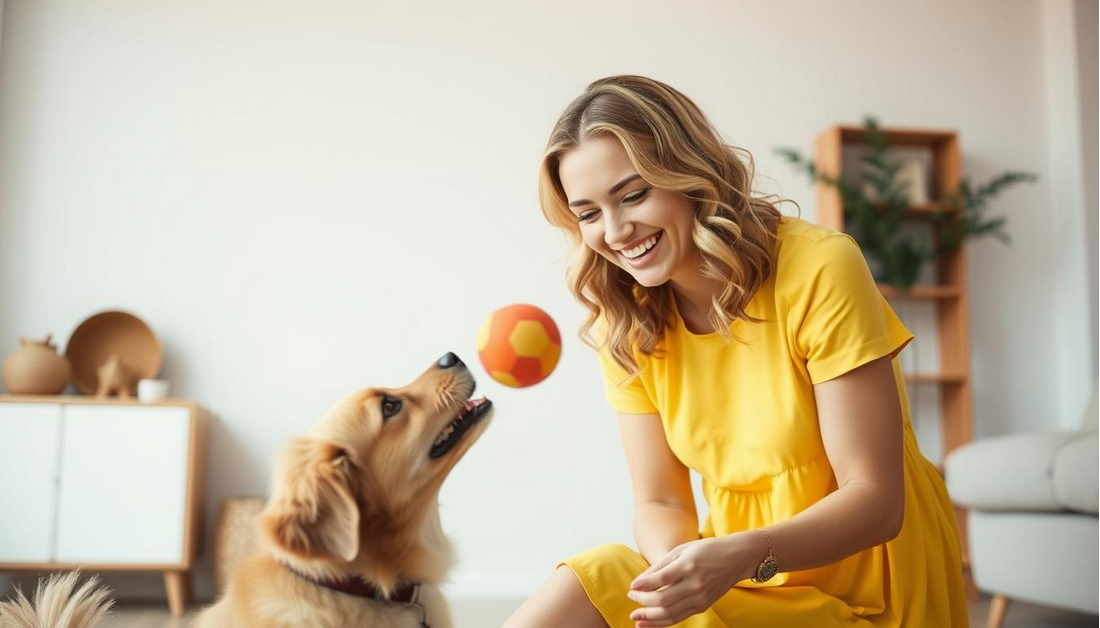
Pet Fitness Revolution: How to Keep Them Active Indoors
Indoor pet exercise has become a crucial aspect of modern pet care, driving the pet fitness revolution forward. As we continue to urbanize, our living spaces are becoming smaller, making it essential to find innovative ways to keep our pets active and healthy indoors.
The Evolution of Indoor Pet Exercise
The concept of indoor pet exercise has evolved significantly over the years. What was once considered a challenge is now a thriving aspect of pet care, with numerous products and activities designed to keep pets engaged and active. The pet fitness revolution is not just about physical health; it’s also about providing mental stimulation to prevent boredom and related behavioral issues.
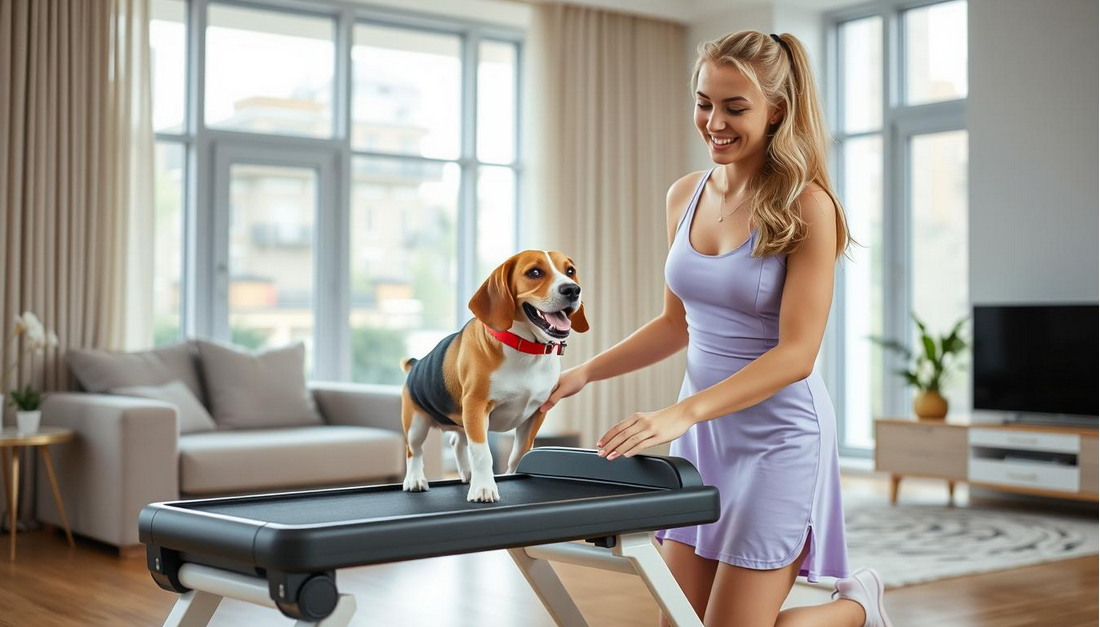
Creating an Exercise-Friendly Home Environment
Transforming your home into an exercise-friendly space is simpler than you think. Start by rearranging furniture to create pathways for your pet to run through or play areas where they can engage in interactive games. Incorporating indoor pet activities into your daily routine can significantly enhance your pet’s physical and mental well-being.
Balancing Physical Workouts with Mental Challenges
A well-rounded pet fitness program includes both physical exercise and mental stimulation. Activities like hide-and-seek, puzzle toys, and obedience training can challenge your pet’s mind, while fetch games and treadmill workouts address physical needs. Balancing workouts and mental challenges is key to a happy, healthy pet.
Setting Realistic Fitness Goals for Your Pet
When embarking on the pet fitness revolution, it’s crucial to set realistic fitness goals for your pet. Consider their age, breed, and health status when designing an exercise plan. Gradually increasing the intensity and duration of workouts can help prevent injuries and ensure long-term success.
| Pet Category | Recommended Activities | Frequency |
|---|---|---|
| Dogs | Fetch, Treadmill, Obedience Training | Daily |
| Cats | Laser Pointer Play, Feather Teaser, Climbing Structures | Multiple short sessions |
By embracing the pet fitness revolution and incorporating these strategies into your daily routine, you can significantly improve your pet’s quality of life. Remember, every pet is unique, so it’s essential to tailor your approach to their individual needs and preferences.
Indoor Workout Ideas for Dogs
Dogs need regular physical and mental stimulation, which can be achieved through various indoor activities. These exercises are crucial for maintaining their overall health and happiness, especially when outdoor activities are limited.
Interactive Play Sessions
Engage your dog in interactive play sessions using toys and puzzle games that challenge their minds and keep them active. Examples include hide-and-seek games and treat-dispensing toys.
Training Games That Double as Exercise
Training games such as “sit,” “stay,” and “fetch” can be adapted into fun, physically demanding activities. These games not only provide exercise but also strengthen the bond between you and your dog.
Indoor Fetch and Retrieval Activities
Indoor fetch is a great way to keep your dog active. You can throw a ball down a hallway or use a soft toy to play catch in a large room. This activity provides excellent cardiovascular exercise.
Treadmill Training for Dogs
For those with the space and resources, treadmill training is a viable option. It allows your dog to run or walk while staying indoors, providing a controlled environment for exercise.
| Activity | Benefits | Tips |
|---|---|---|
| Interactive Play | Mental Stimulation, Physical Exercise | Use varied toys and rotate them regularly |
| Training Games | Physical Exercise, Bonding | Keep sessions short and fun |
| Indoor Fetch | Cardiovascular Exercise | Use soft toys to avoid damage |
| Treadmill Training | Controlled Exercise Environment | Start with slow speeds and gradually increase |
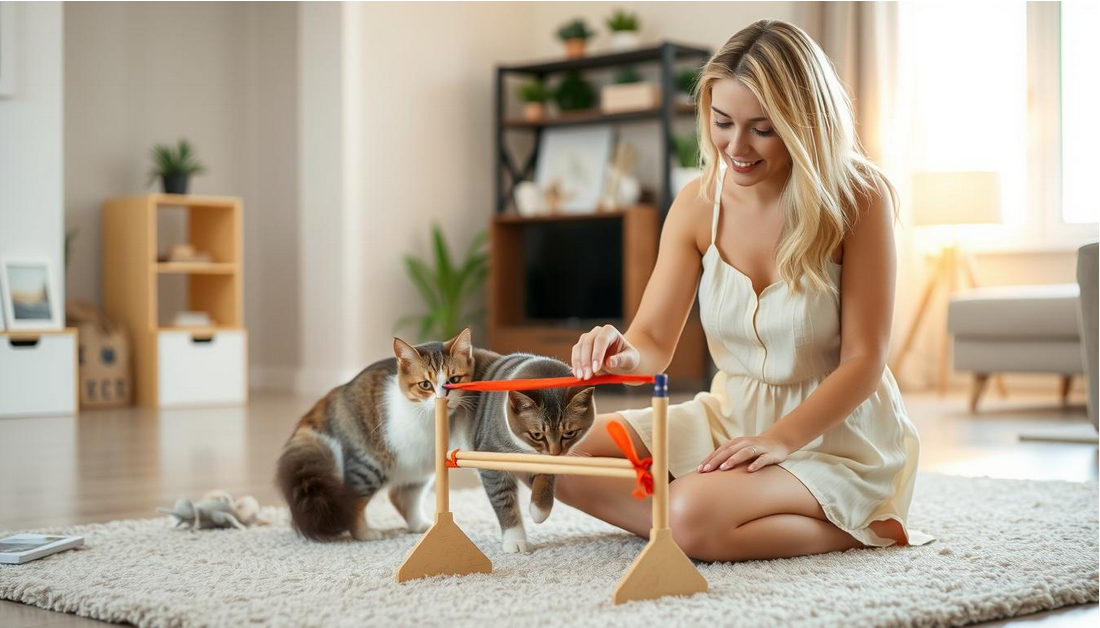
Creative Ways to Keep Cats Active Indoors
Indoor cats require creative stimulation to maintain their physical and mental well-being. Without adequate exercise, cats can become obese, develop behavioral problems, or suffer from other health issues. Fortunately, there are several engaging ways to keep your cat active indoors.
Vertical Space Utilization Strategies
Cats love to climb and perch. Utilizing vertical space with cat shelves or cat trees can encourage your cat to be more active. Cat trees provide multiple levels for climbing, playing, and observing their surroundings, keeping them engaged and active.

Prey-Drive Stimulating Activities
Stimulating a cat’s prey drive can be achieved through interactive play with feather wands or laser pointers. These activities mimic hunting, encouraging natural behavior and providing exercise.
Interactive Toys for Independent Play
Interactive toys that allow cats to play independently are great for times when you’re not available to engage in play. Battery-operated toys or puzzle toys filled with treats challenge cats and keep them active.
Rotation Systems to Maintain Interest
To prevent boredom, it’s essential to rotate toys and activities regularly. Introducing new toys or reintroducing old ones after a while can keep your cat interested and engaged.
By implementing these strategies, you can ensure your cat remains active and healthy indoors. Regular exercise and mental stimulation are key to a happy and balanced feline companion.
Essential Equipment for the Home Pet Gym
With the right equipment, you can turn your home into a vibrant pet gym that keeps your pet active and engaged. Creating a home pet gym doesn’t have to be expensive or require a lot of space. By investing in the right tools and toys, you can provide your pet with a fun and effective way to stay active indoors.

Must-Have Toys and Exercise Tools
To get started, you’ll need some essential toys and exercise tools. Interactive puzzle toys are great for mental stimulation, while tug toys and fetch balls provide physical exercise. For dogs, a sturdy rope toy or a durable chew toy can be a great addition to your home pet gym.
Space-Efficient Fitness Equipment
For pet owners with limited space, there are several space-efficient fitness equipment options available. Tunnels and cones can be used to create an obstacle course, while a compact treadmill provides a convenient way to give your dog a cardio workout.
Budget-Friendly Options
Creating a home pet gym doesn’t have to break the bank. You can start with DIY puzzle toys made from household items or opt for affordable interactive toys available online. For dogs, a simple fetch ball or a tug toy can be an effective and budget-friendly option.
High-Tech Pet Exercise Solutions
For tech-savvy pet owners, there are several high-tech pet exercise solutions available. Automated treat-dispensing toys and remote-controlled toys can provide mental stimulation and physical exercise. You can also consider investing in a smart pet feeder or a pet fitness tracker to monitor your pet’s activity levels.
By incorporating these essential equipment and toys into your home pet gym, you can create a fun and engaging environment that keeps your pet active, happy, and healthy.
Establishing an Effective Indoor Exercise Routine
Establishing a consistent exercise schedule is crucial for maintaining your pet’s overall well-being indoors. A well-structured routine not only keeps your pet physically active but also mentally stimulated.
Scheduling Regular Activity Sessions
To create an effective indoor exercise routine, start by scheduling regular activity sessions. This could be as simple as dedicating 15-20 minutes twice a day to playtime or more structured activities like training sessions.
Mixing Activities to Prevent Boredom
Mixing up the activities is key to preventing boredom. For example, one day you could play hide-and-seek, and the next, engage in a tug-of-war game or use interactive toys.
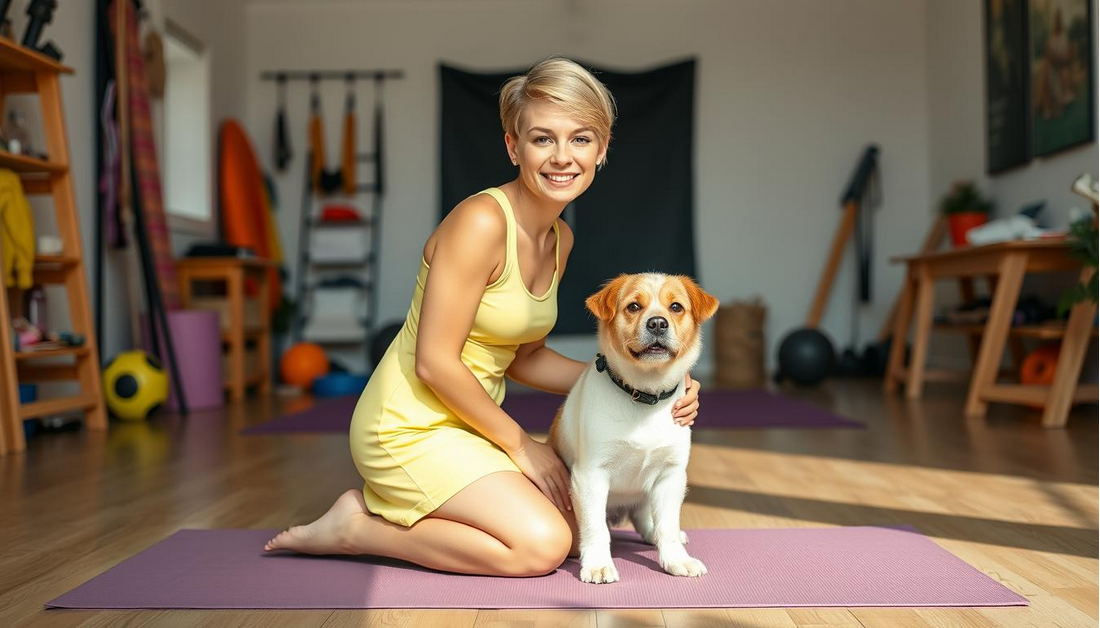
Adapting Routines for Working Pet Parents
For working pet parents, adapting the routine to fit their schedule is essential. This might mean breaking exercise into shorter sessions or using automated toys.
Tracking Progress and Making Adjustments
Tracking your pet’s progress and adjusting the routine as needed is vital. Monitor their energy levels and adjust activities accordingly.
| Activity Type | Frequency | Duration |
|---|---|---|
| Playtime | Twice a day | 15-20 minutes |
| Training Sessions | Once a day | 10-15 minutes |
| Interactive Toys | Daily | Varies |
DIY Indoor Pet Fitness Hacks
Transforming your home into a pet fitness haven can be both fun and cost-effective with these DIY indoor pet fitness hacks. Engaging in DIY projects allows you to tailor activities to your pet’s specific needs while saving money.
Homemade Obstacle Courses
Creating a homemade obstacle course is an excellent way to keep your pets active indoors. Use household items like cardboard boxes, tunnels, and chairs to set up a challenging course. For instance, you can create a simple weave-through course using chairs or a tunnel using a cardboard box.
Repururposing Household Items
Repurposing household items is a creative way to provide exercise for your pets. Old blankets can become tug toys, and plastic bottles can be turned into interactive feeders. This not only reduces waste but also keeps your pets engaged.
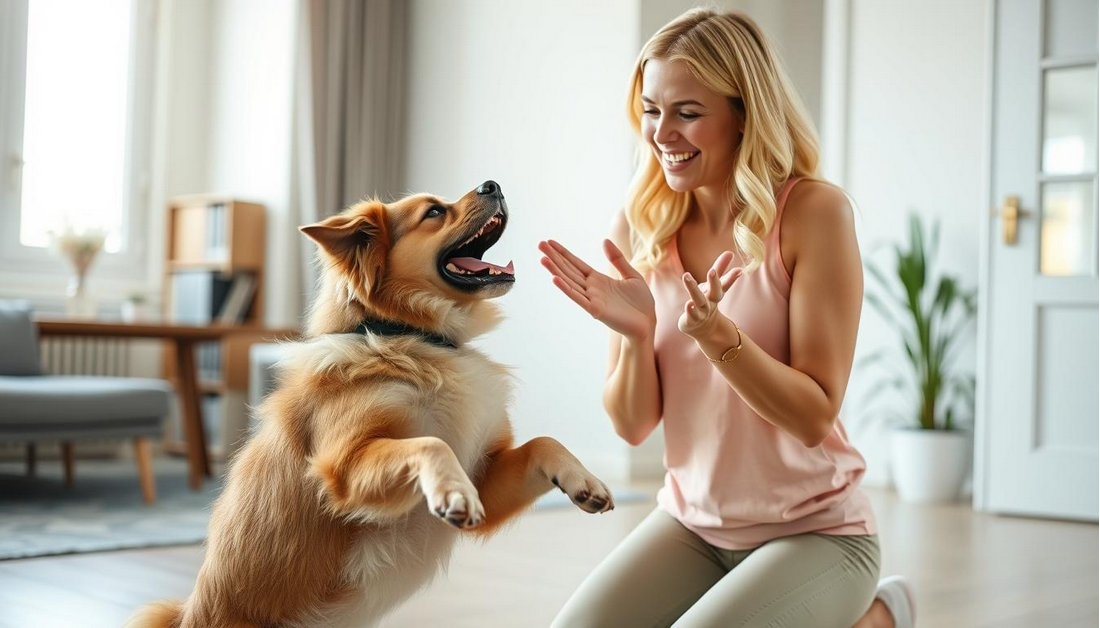
DIY Puzzle Toys
DIY puzzle toys are an excellent way to provide mental stimulation. You can create simple puzzle toys using cardboard and treats. For example, cut holes of varying sizes in a cardboard box and fill it with treats, challenging your pet to figure out how to get them out.
No-Cost Exercise Solutions
There are several no-cost exercise solutions you can implement. Stair climbing, hide-and-seek, and even dancing with your pet are all effective ways to keep them active without spending a dime.
| DIY Project | Description | Benefit |
|---|---|---|
| Homemade Obstacle Course | Using household items to create a course | Physical Exercise |
| Repurposed Household Items | Turning old items into toys or feeders | Reduces Waste, Engaging |
| DIY Puzzle Toys | Creating toys from cardboard and treats | Mental Stimulation |
Smart Technology for Modern Pet Fitness
Smart technology is transforming the way we keep our pets active and healthy indoors. With innovative solutions ranging from fitness trackers to virtual exercise programs, pet owners can now provide their pets with engaging and high-tech exercise experiences.
Pet Fitness Trackers and Monitoring Apps
Pet fitness trackers and monitoring apps have become essential tools for pet owners. These devices track activity levels, monitor health metrics, and provide insights into a pet’s daily habits. For instance, FitBark and Whistle are popular brands offering GPS tracking and activity monitoring. By using these technologies, owners can identify patterns and make informed decisions about their pet’s exercise needs.
Remote-Controlled and Automated Exercise Toys
Remote-controlled and automated exercise toys offer an interactive way to keep pets engaged. Toys like the PetSafe Interactive Toy or the Furbo Dog Camera allow owners to interact with their pets remotely, encouraging physical activity and mental stimulation. These toys can be controlled via smartphone apps, providing flexibility for busy pet owners.
Virtual Pet Exercise Programs and Classes
Virtual pet exercise programs and classes are gaining popularity. These online resources offer guided workouts and training sessions tailored to different pet needs. For example, virtual agility training for dogs or interactive play sessions for cats can be conducted from the comfort of home. Such programs not only provide exercise but also strengthen the bond between pet and owner.
Smart Home Integration for Pet Activities
Integrating smart home technology with pet activities can further enhance their exercise routines. Smart feeders, automated doors, and interactive lighting systems can all contribute to a more engaging environment for pets. By leveraging these technologies, pet owners can create a stimulating and active lifestyle for their pets indoors.
Overcoming Indoor Exercise Challenges
Overcoming the hurdles of indoor pet exercise requires creativity and understanding of pet needs, leading to a healthier pet lifestyle. Despite the best intentions, pet owners often face challenges when trying to keep their pets active indoors.
Solutions for Limited Living Spaces
For those living in apartments or homes with limited space, there are still numerous ways to keep pets active. Utilizing vertical space with cat shelves or dog ladders can be an effective solution. Additionally, compact exercise equipment like foldable treadmills or interactive toys can help.
Motivating Reluctant or Low-Energy Pets
Some pets may be reluctant to exercise due to low energy or lack of motivation. Using high-value treats and engaging toys can encourage participation in physical activities.
Managing Multiple Pets with Different Needs
Managing multiple pets requires a tailored approach. Creating a rotating schedule for exercise and play can ensure each pet’s needs are met without feeling overwhelmed.
Addressing Noise Concerns in Apartments
For apartment dwellers, noise can be a significant concern. Opting for quiet exercise equipment or silent play activities like puzzle toys can help mitigate this issue.
| Challenge | Solution |
|---|---|
| Limited Living Spaces | Utilize vertical space, compact exercise equipment |
| Reluctant or Low-Energy Pets | High-value treats, engaging toys |
| Managing Multiple Pets | Rotating schedule for exercise and play |
| Noise Concerns in Apartments | Quiet exercise equipment, silent play activities |
Conclusion: Embracing the Indoor Pet Fitness Lifestyle
Adopting an indoor pet fitness lifestyle is a significant step towards ensuring the overall health and well-being of your pets. By incorporating the strategies and ideas discussed throughout this article, pet owners can provide their pets with active, engaged lives, even when indoors.
The pet fitness revolution is not just about exercise; it’s about creating a lifestyle that prioritizes pet health and wellness. This includes maintaining healthy pet habits, such as regular activity sessions and mental stimulation, to prevent obesity and related health issues.
By exploring the many ways to keep pets fit, happy, and healthy indoors, pet owners can make informed decisions about their pet’s wellness. This includes utilizing essential equipment, establishing effective indoor exercise routines, and leveraging smart technology for modern pet fitness.
Embracing this lifestyle is a commitment to providing pets with the best possible life. By doing so, pet owners can enjoy a stronger, more loving bond with their pets, built on the foundation of mutual health and happiness. Following these pet wellness tips can lead to a more fulfilling life for both pets and their owners.
FAQ
What are some fun indoor activities to keep my dog active?
You can try interactive play sessions, training games that double as exercise, and indoor fetch and retrieval activities to keep your dog engaged and active. Treadmill training is also a great option if you have the space and resources.
How can I keep my cat active indoors?
Utilize vertical space with cat shelves or climbing structures, stimulate their prey drive with feather toys or laser pointers, and use interactive toys that encourage independent play. Rotating toys regularly can also help maintain their interest.
What are some essential equipment for a home pet gym?
Must-have toys and exercise tools include interactive toys, puzzle toys, and fetch toys. Space-efficient fitness equipment like treadmills or compact agility equipment can also be useful. Budget-friendly options include household items repurposed for exercise, like cardboard boxes or paper bags.
How do I establish an effective indoor exercise routine for my pet?
Schedule regular activity sessions, mix activities to prevent boredom, and adapt routines for your lifestyle. For working pet parents, consider breaking exercise into shorter sessions throughout the day or using automated exercise toys.
What are some DIY indoor pet fitness hacks?
Create homemade obstacle courses using household items, repurpose items like cardboard boxes or tunnels for exercise, and make DIY puzzle toys to challenge your pet mentally. No-cost exercise solutions include playing with your pet using your hands or voice commands.
How can smart technology help with pet fitness?
Pet fitness trackers and monitoring apps can help track your pet’s activity levels, while remote-controlled and automated exercise toys can provide exercise when you’re not home. Virtual pet exercise programs and classes can also offer guidance and variety.
What are some solutions for limited living spaces?
Consider compact or wall-mounted exercise equipment, like foldable treadmills or wall-mounted cat shelves. You can also opt for low-space activities like hide-and-seek, scent games, or interactive toys.
How can I motivate a reluctant or low-energy pet?
Start with short, gentle exercise sessions and gradually increase intensity and duration. Use positive reinforcement techniques, like treats and praise, to encourage participation. Consult with a veterinarian to rule out underlying health issues.
How can I manage multiple pets with different needs?
Create separate exercise routines for each pet, taking into account their individual needs, ages, and health factors. Consider staggered exercise sessions to prevent overwhelming or stressing your pets.







